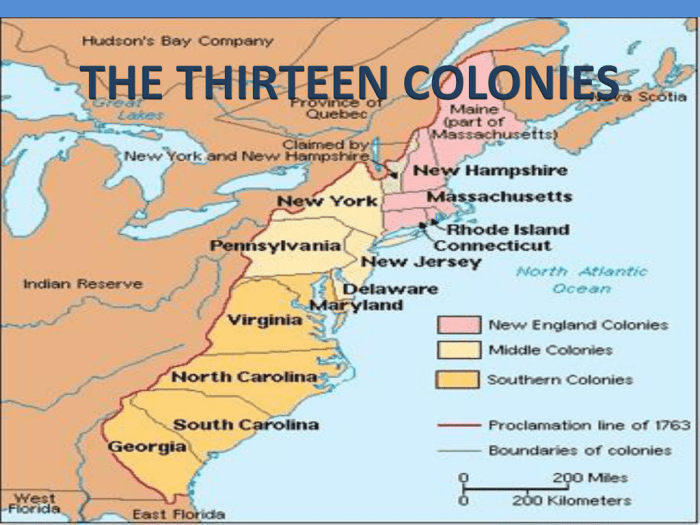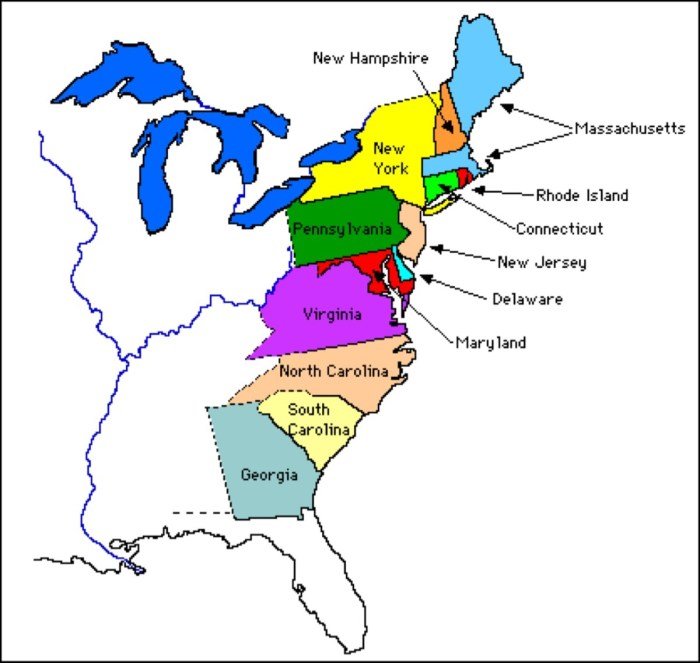Unveiling the thirteen colonies map with rivers is like stepping into a time capsule that transports us back to the very heart of American history. This comprehensive guide delves into the significance of these waterways, their influence on the development of the colonies, and their enduring legacy in shaping the nation’s identity.
The map showcases the geographical location and boundaries of the thirteen colonies, highlighting the major rivers that played a pivotal role in their economic, strategic, and cultural development. From the mighty Mississippi River to the bustling Hudson River, these waterways were the lifeblood of colonial America.
Historical Overview: Thirteen Colonies Map With Rivers

The thirteen colonies played a pivotal role in the founding of the United States of America. Established along the Atlantic coast of North America, these colonies were the cradle of American identity, culture, and political institutions.
The geographical boundaries of the thirteen colonies extended from present-day Maine in the north to Georgia in the south. To the west, the colonies were bounded by the Appalachian Mountains, while the Atlantic Ocean formed their eastern border.
Map Analysis
The map below provides a detailed representation of the thirteen colonies, highlighting major rivers and waterways. The legend explains the symbols and colors used on the map.

Legend:
- Red lines: Major rivers
- Blue lines: Smaller rivers and streams
- Green areas: Coastal regions
- Brown areas: Mountainous regions
River Systems
The thirteen colonies were traversed by a network of major river systems, including:
- Hudson River:Flowed through New York and New Jersey, providing a vital transportation route and a source of water for agriculture and industry.
- Delaware River:Formed the border between Pennsylvania and New Jersey, and was important for trade and commerce.
- Potomac River:Flowed through Maryland and Virginia, and was used for transportation and fishing.
- James River:Flowed through Virginia, and was a major source of tobacco cultivation.
- Savannah River:Formed the border between Georgia and South Carolina, and was used for trade and transportation.
Economic Impact, Thirteen colonies map with rivers
Rivers played a crucial role in the economic development of the thirteen colonies:
- Agriculture:Rivers provided water for irrigation, and transported agricultural products to markets.
- Industry:Rivers provided power for mills and factories, and facilitated the transportation of raw materials and finished goods.
- Transportation:Rivers were the primary means of transportation for people and goods, connecting inland areas with coastal ports.
For example, the Hudson River was a major transportation route for goods from the interior to New York City, while the James River was used to transport tobacco from Virginia plantations to markets in Europe.
Strategic Importance
During the American Revolutionary War, rivers played a significant strategic role:
- Transportation:Rivers were used to transport troops, supplies, and weapons to battlefields.
- Supply lines:Rivers provided supply lines for armies, ensuring a steady flow of food, ammunition, and other resources.
- Military campaigns:Rivers were often used as natural barriers or defensive positions, and were the sites of key battles.
For example, the Hudson River was a strategic waterway for the British, who used it to control access to New York City and the Hudson Valley.
Environmental Significance
Rivers were vital to the ecological health of the thirteen colonies:
- Water supply:Rivers provided drinking water, water for irrigation, and water for industrial and domestic uses.
- Habitat:Rivers provided habitat for a variety of fish, wildlife, and plant species.
- Natural resources:Rivers were a source of fish, timber, and other natural resources.
However, human activities, such as deforestation and pollution, had a negative impact on river ecosystems in the thirteen colonies.
Cultural Legacy
Rivers have played a significant role in the folklore, literature, and art of the thirteen colonies:
- Folklore:Rivers have been featured in folk tales, legends, and songs.
- Literature:Rivers have been a setting for many works of American literature, including Mark Twain’s The Adventures of Huckleberry Finnand Nathaniel Hawthorne’s The House of the Seven Gables.
- Art:Rivers have been depicted in paintings, sculptures, and other works of art.
Rivers have helped to shape the identity and heritage of the thirteen colonies and the United States as a whole.
Key Questions Answered
What were the major river systems in the thirteen colonies?
The major river systems included the Mississippi River, Hudson River, Delaware River, Potomac River, and Connecticut River.
How did rivers influence the economy of the colonies?
Rivers provided transportation routes for trade and commerce, facilitated the development of agriculture and industry, and served as a source of water power.
What was the strategic importance of rivers during the American Revolutionary War?
Rivers were used for transportation of troops and supplies, served as natural barriers against enemy advances, and provided strategic advantages for military campaigns.

